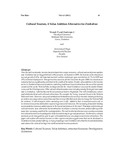Please use this identifier to cite or link to this item:
https://cris.library.msu.ac.zw//handle/11408/744Full metadata record
| DC Field | Value | Language |
|---|---|---|
| dc.contributor.author | Siwadi, Patience | - |
| dc.contributor.author | Chaderopa, C. | - |
| dc.date.accessioned | 2015-12-08T14:39:09Z | - |
| dc.date.available | 2015-12-08T14:39:09Z | - |
| dc.date.issued | 2012 | - |
| dc.identifier.issn | 1815-9036 | - |
| dc.identifier.uri | http://hdl.handle.net/11408/744 | - |
| dc.description.abstract | Over the last two decades, tourism has developed into a major economic, cultural and social preoccupation and Zimbabwe has not lagged behind in this scenario. At its peak in 1999, the tourism sector showed an annual growth of 18%. Arrivals had reached 2 million visitors per year contribution to 7% to GDP and 15% to formal employment. Though tourism was at an all time low from the year 2000 it is viewed as an industry that can significantly contribute to the wealth of the nation. To date, value addition in the tourism sector in Zimbabwe has concentrated on exploiting traditional tourist attractions like one of the natural wonders of the world, Victoria Falls, heritage sites like the Great Zimbabwe ruins and the smaller Khami ruins, and the Chinhoyi caves. Other natural attractions also come into play namely the largest man made lake in Zimbabwe, Lake Kariba and the mountainous Eastern Highlands. The rich Zimbabwean culture and beliefs also blend well with such attractions. For example the living museum found in the Victoria Falls resort area. However, using such products as the backbone of a country s tourism industry is limiting as visitors can enjoy a site so many times and there is very little that can be done to change the Victoria Falls for instance. It will always be water cascading over a cliff. Added to that, to maintain such a site or environment as a prime destination requires huge amount of resources. The increasing demand for holiday accommodation means an added expense to the tourist and pressure to the resort. This paper seeks to discuss cultural tourism as an alternative tourist attraction to enhance a country s tourism product offering at the same time increasing wealth of the rural population. The visit to sites have become mere one day excursions but cultural tourism can be packaged to entice tourists to stay longer and spend more. Furthermore, cultural products can be changed from year to year with added features, new players and diverse attractions. The paper will explore alternative tourism in other regions and also suggest areas that can be developed in Zimbabwe tourism product offering in trying to package rural Zimbabwe into attractive tourist destinations and enhance the cultural heritage into world acclaimed tourism products. | en_US |
| dc.language.iso | en | en_US |
| dc.publisher | Midlands State University | en_US |
| dc.relation.ispartofseries | The Dyke;Vol. 6; No. 3; p.63-76 | - |
| dc.subject | Cultural tourism, value addition, attraction economic development, Zimbabwe | en_US |
| dc.title | Cultural tourism, a value addition alternative for Zimbabwe | en_US |
| dc.type | Article | en_US |
| item.grantfulltext | open | - |
| item.cerifentitytype | Publications | - |
| item.openairetype | Article | - |
| item.fulltext | With Fulltext | - |
| item.openairecristype | http://purl.org/coar/resource_type/c_18cf | - |
| item.languageiso639-1 | en | - |
| Appears in Collections: | Conference Papers | |
Files in This Item:
| File | Description | Size | Format | |
|---|---|---|---|---|
| tourism.pdf | 212.58 kB | Adobe PDF |  View/Open |
Page view(s)
282
checked on Jan 20, 2026
Download(s)
438
checked on Jan 20, 2026
Google ScholarTM
Check
Items in MSUIR are protected by copyright, with all rights reserved, unless otherwise indicated.



